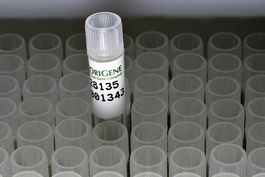Caspr (CNTNAP1) (NM_003632) Human Tagged ORF Clone
CAT#: RC218019L2
- LentiORF®
Lenti ORF clone of Human contactin associated protein 1 (CNTNAP1), mGFP tagged
"NM_003632" in other vectors (6)
Product Images

Specifications
| Product Data | |
| Type | Human Tagged ORF Clone |
| Tag | mGFP |
| Symbol | CNTNAP1 |
| Synonyms | CASPR; CHN3; CNTNAP; NRXN4; P190 |
| Vector | pLenti-C-mGFP |
| E. coli Selection | Chloramphenicol (34 ug/mL) |
| Mammalian Cell Selection | None |
| Sequence Data |
The ORF insert of this clone is exactly the same as(RC218019).
|
| Restriction Sites | SgfI-MluI Cloning Scheme for this gene |
| ACCN | NM_003632 |
| ORF Size | 4152 bp |
| OTI Disclaimer | The molecular sequence of this clone aligns with the gene accession number as a point of reference only. However, individual transcript sequences of the same gene can differ through naturally occurring variations (e.g. polymorphisms), each with its own valid existence. This clone is substantially in agreement with the reference, but a complete review of all prevailing variants is recommended prior to use. More info |
| OTI Annotation | This clone was engineered to express the complete ORF with an expression tag. Expression varies depending on the nature of the gene. |
| Reference Data | |
| RefSeq | NM_003632.1, NP_003623.1 |
| RefSeq Size | 5293 |
| RefSeq ORF | 4155 |
| Locus ID | 8506 |
| Domains | F5_F8_type_C, LamG, EGF |
| Protein Families | Druggable Genome, Transmembrane |
| Protein Pathways | Cell adhesion molecules (CAMs) |
| MW | 156.27 kDa |
| Gene Summary | The gene product was initially identified as a 190-kD protein associated with the contactin-PTPRZ1 complex. The 1,384-amino acid protein, also designated p190 or CASPR for 'contactin-associated protein,' includes an extracellular domain with several putative protein-protein interaction domains, a putative transmembrane domain, and a 74-amino acid cytoplasmic domain. Northern blot analysis showed that the gene is transcribed predominantly in brain as a transcript of 6.2 kb, with weak expression in several other tissues tested. The architecture of its extracellular domain is similar to that of neurexins, and this protein may be the signaling subunit of contactin, enabling recruitment and activation of intracellular signaling pathways in neurons. [provided by RefSeq, Jan 2009] |
Documents
| Product Manuals |
| FAQs |
| SDS |
Resources
Other Versions
| SKU | Description | Size | Price |
|---|---|---|---|
| SC117823 | CNTNAP1 (untagged)-Human contactin associated protein 1 (CNTNAP1) |
USD 2,800.00 |
|
| RC218019 | CNTNAP1 (Myc-DDK-tagged)-Human contactin associated protein 1 (CNTNAP1) |
USD 1,140.00 |
|
| RG218019 | CNTNAP1 (GFP-tagged) - Human contactin associated protein 1 (CNTNAP1) |
USD 1,250.00 |
|
| RC218019L1 | Lenti ORF clone of Human contactin associated protein 1 (CNTNAP1), Myc-DDK-tagged |
USD 1,656.00 |
|
| RC218019L3 | Lenti ORF clone of Human contactin associated protein 1 (CNTNAP1), Myc-DDK-tagged |
USD 1,656.00 |
|
| RC218019L4 | Lenti ORF clone of Human contactin associated protein 1 (CNTNAP1), mGFP tagged |
USD 1,340.00 |
{0} Product Review(s)
Be the first one to submit a review






























































































































































































































































 Germany
Germany
 Japan
Japan
 United Kingdom
United Kingdom
 China
China
